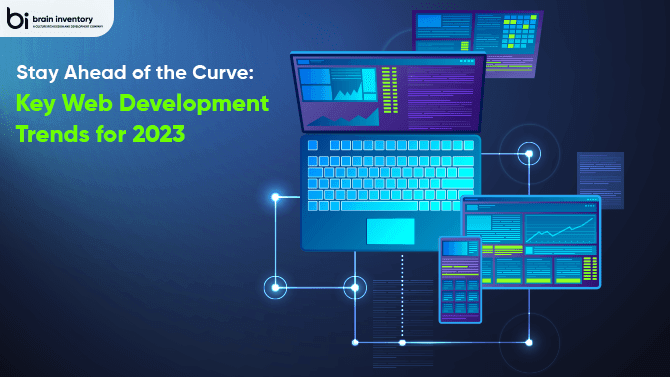Stay Ahead of the Curve: Key Web Development Trends for 2023

Quick Summary: In the dynamic world of web development, staying at the forefront demands continuous adaptation. With the constant evolution of technology and evolving user demands, development teams must embrace emerging trends to ensure they provide outstanding user experiences.
Web Development Trends to Keep an Eye on in 2023
As we enter the year 2023, web developers and businesses need to stay updated with the latest web development trends. There are trends that drive the digital landscape – ensuring sites remain relevant, engaging, and user-friendly. Over the years, we have seen many modern trends shaping the web development industry, which later became popular. They continue to be in trend until time changes.
Responsive Design: Responsive design is becoming more and more important these days. We are getting more devices and more connections. Due to the recent upsurge, users are now accessing the Internet from a variety of devices (like smartphones and tablet computers). Developing responsive websites means that all your website’s elements resize automatically according to the screen size and resolution of your visitor’s device.
Responsive design empowers developers to craft adaptable layouts, resize images seamlessly, and implement dynamic navigation systems, ensuring an excellent viewing experience on a variety of devices.
Progressive Web Apps: Progressive Web Apps combine the best of both web and mobile app experiences to create user experiences that are just plain better than either. The real power of this new approach is in its focus on the user. A Progressive Web App is, by definition, inherently more useful when it’s accessed over a network connection because it loads instantly and can be used offline. In addition to the fluidity and usability afforded by an app-like experience, PWAs address an existing issue with how users actually access the web — a significant number of users simply access content via search engines without ever visiting a website.
Voice User Interface: Voice user interfaces, commonly referred to as voice UIs or VUIs, are a new type of interface that allows users to interact with websites, apps, and devices through vocal commands. Voice interaction once believed to be a niche feature for leisure and entertainment applications, has become increasingly popular with the rise of voice assistants like Amazon’s Alexa and Apple’s Siri.
Voice User Interface (VUI) delivers a more intuitive experience to users as they interact with your website via voice command. VUI relies on technologies such as speech recognition and natural language processing to accept verbal input from users and convert it into commands or actions. Consequently, it allows developers to improve the end-user experience by adding features such as voice search or voice-activated assistants.
Enhancing Website Visuals: Ideally, the visual appeal should be incorporated into a website’s design process as this will allow for greater flexibility, scalability, and efficiency. This means that all elements of the site — including stylesheets, graphics, images, and color schemes — should all work effectively in unison. Having said that, businesses can also consider exploring third-party plugins or extensions to expand functionality and integrate with all the major platforms (i.e. WordPress, Magento, Joomla). This is also an important step when integrating visual effects to ensure silky smooth navigation throughout a website and prevent any technical glitches.
Artificial Intelligence Integration: AI has become a transformative force for the web development industry, and it’s here to stay. Whether it’s chatbots interacting with new or returning visitors, content recommendation engines suggesting pieces relevant to a visitor’s preferences and interests, or personalization options delivering the best possible online experience, AI-powered technologies are set to drastically improve how brands interact with their ideal audiences.
With the rise of artificial intelligence (AI), web developers need to be aware of these computational methods and techniques, and how they can be used to improve user experience. By leveraging their ability to respond to user behavior and activity, implement individualized recommendations, and even automate certain tasks, AI technologies can help you build better websites.
Low-Code/No-Code Development: Low-code and no-code development platforms help empower non-technical users to build functional websites and apps who otherwise could not build them. By building visual interfaces, drag-and-drop functionality, and prebuilt modules, these platforms make it easy for users with limited coding experience to create functional sites.
Single Page Applications: Single-page applications are hugely popular among developers because they offer an experience that is superior to multi-page applications for users. While contents and themes still need to be custom-made, the interface allows continuous interaction with the website, without the distractions brought on by page reloads. There’s also a positive impact on SEO since single-page applications deliver better user experiences.
Single-page applications (SPAs) can be a great way to make your website faster and more responsive to users, with smoother interactions and reduced load times. They also allow offline capabilities so that users with internet connections aren’t cut off from your website.
Web Accessibility: As web design trends change and new technologies emerge, it sometimes seems like we’ve regressed when it comes to accessibility. But this is far from the truth – accessibility has always been a crucial aspect of web development, focusing on ensuring that websites are usable by individuals with disabilities. Creating accessible websites ensures inclusivity for users with various disabilities, such as visual or hearing impairments, motor limitations, and cognitive challenges.
Cybersecurity and Privacy: As technology advances, so must the procedures and systems we use to protect it. This includes cybersecurity and user privacy. As web developers working on client sites, our job isn’t just to establish security measures; we also need to build trust. Implementing robust security measures like SSL certificates, secure login systems, and encryption protocols helps us reach this goal by safeguarding user data and using new technologies designed to enhance privacy.
Developers need to stay updated on privacy regulations. Adhering to the most recent regulations helps developers make sure their websites, apps, and APIs are secure. As more personal information is exchanged online, it is becoming increasingly important for developers to build secure software. This includes protecting against threats that could otherwise undermine all the trust users have in their devices and apps.
Dark Mode: Dark mode, also known as Night Mode or Twilight, is a setting that was originally designed to help enhance aesthetically pleasing screens. However, it’s recently gained popularity for more practical reasons, namely the benefits it provides for users and their devices. It has been implemented in operating systems, video editing tools, and different kinds of apps. Dark mode not only enhances the look and feel of a device but can also offer significant battery life savings through decreased screen brightness as well as improved readability of static content.
Conclusion
The new techniques and tools for responsive web design are essential to the future of your career. As with any job, a developer’s skill set is something that needs constant updating. Learning new techniques will help you stay relevant in a sector that’s advancing at an incredibly fast pace. Are you ready to take your web development projects to the next level?
Brain Inventory is an innovative IT company that specializes in creating revolutionary digital solutions for business owners and entrepreneurs alike. We integrate the latest trends and technologies to create websites and apps that truly stand out. By focusing on results-driven digital marketing, our team of experienced designers, website coders, and app developers understands that businesses work differently today. If you want more traffic, revenue, leads, or increased brand awareness from your online presence – feel free to get in touch with us today!

Have an idea?
Get in touch, we’d be
happy to hear from you
We are always looking out for new collaborations, whether you are a client who is passionate about a project or a talent who is interested in joining our team, our doors are always open.
locate us

India (HQ)
618, Shekhar Central, Palasia Square, A.B Road, Indore, Madhya Pradesh, 452001
+918109561401

United Kingdom
Brain Inventory, SBVS, 8 Roundhay Road, Leeds, UK, LS7 1AB
+18008209286

Canada
44 Main Street East Milton, ONCanada L9T 1N3
+4166696505

Jordan
185 Wasfi Al-Tal Street, Ammon Oasis Complex P.O Box 4724 Amman 11953 Jordan
+960770781000

USA
720 Seneca St Ste 107 Seattle, USA 98101
+1(206)6533419
if it's digital,we'll make it.
- Numetric - Online Accounting Software similar to QuickBooks
- Bloomia - Kegel exercise
- Virifi - Blockchain Powered Document Certification & Signing Platform
- Revolution Travel CRM - Custom CRM Built for Travel Agents
- Fatoura - Online Invoicing Platform
- My Fit Mantra - Your health partner
- Ocureel - Relation Building and video sharing Application